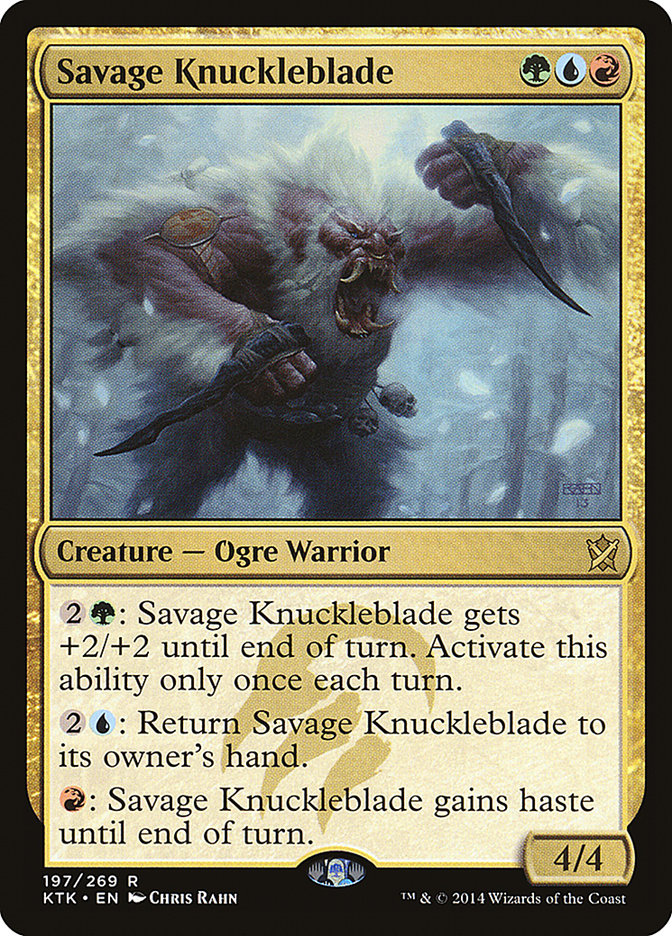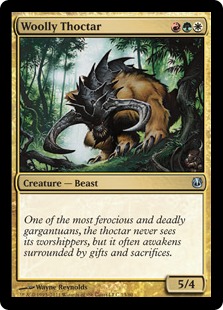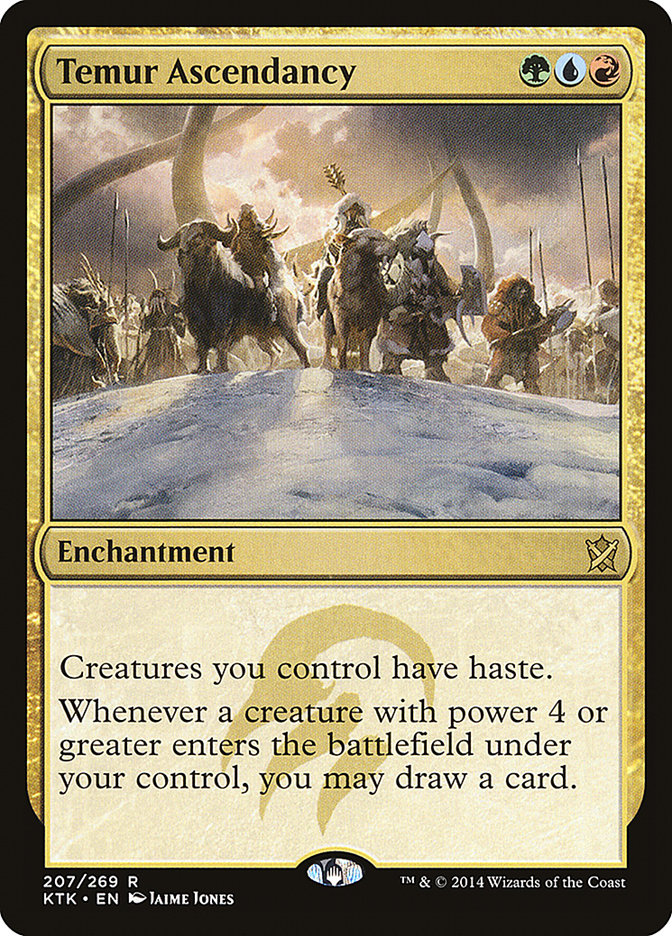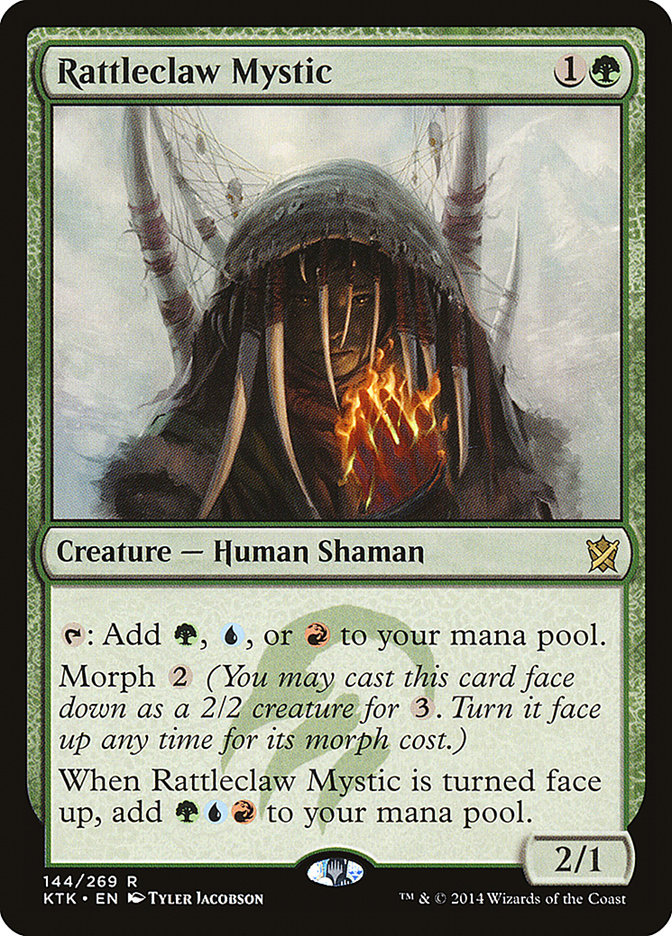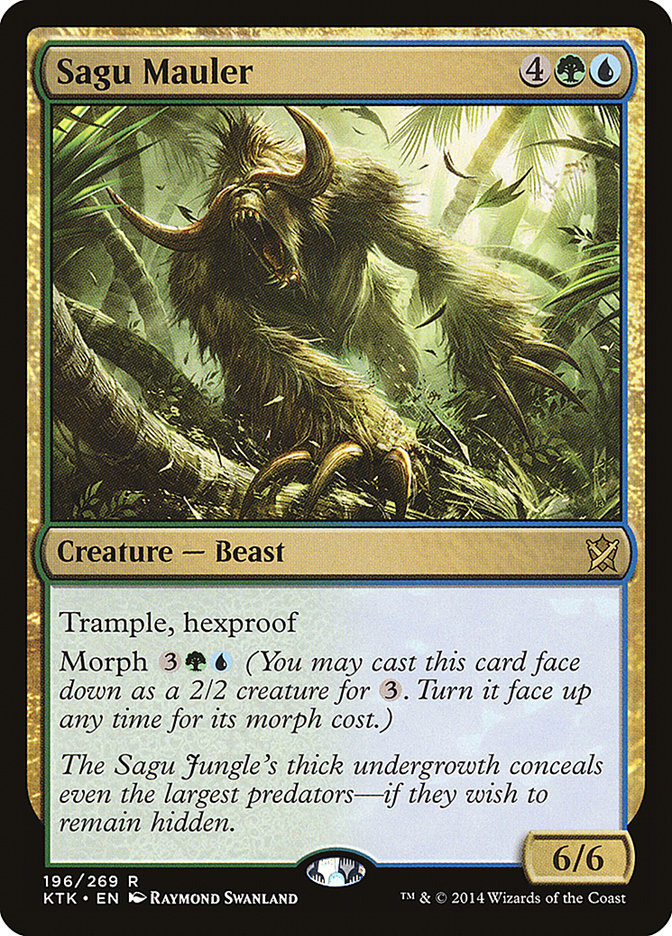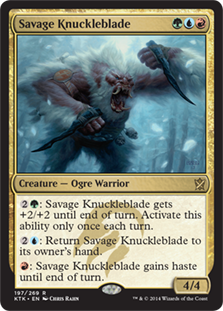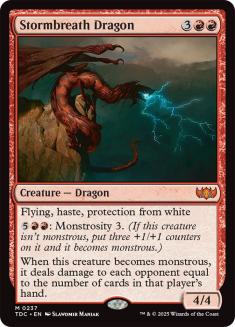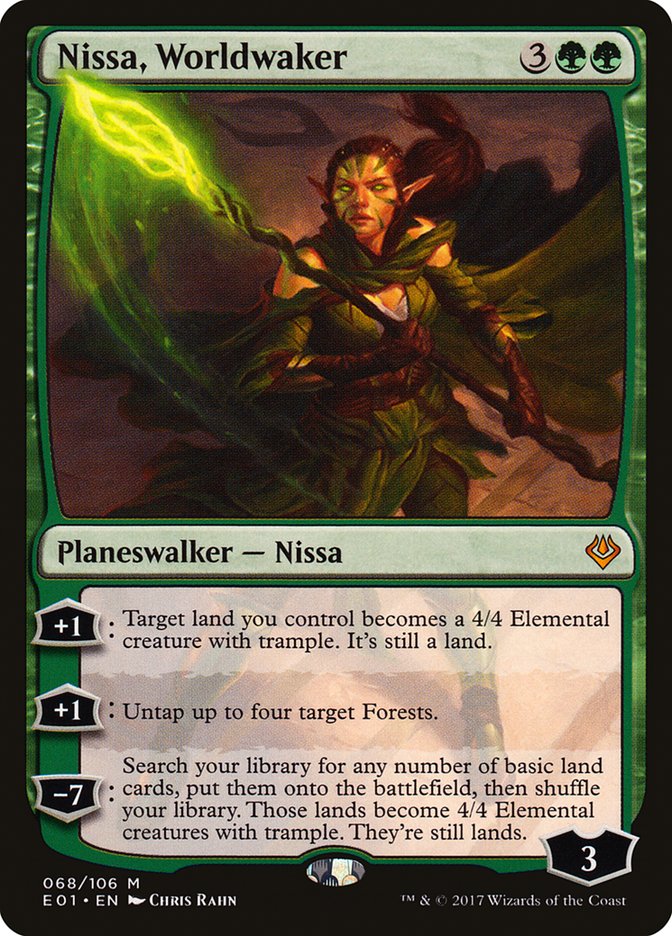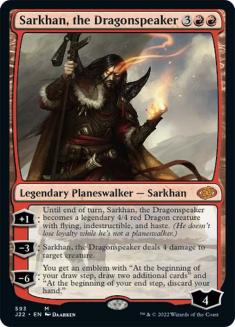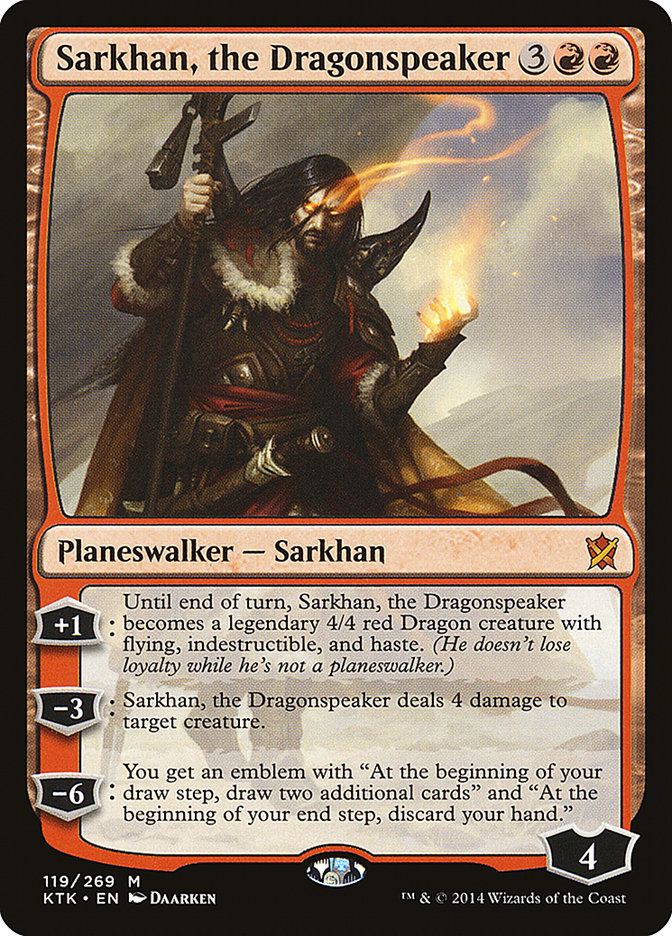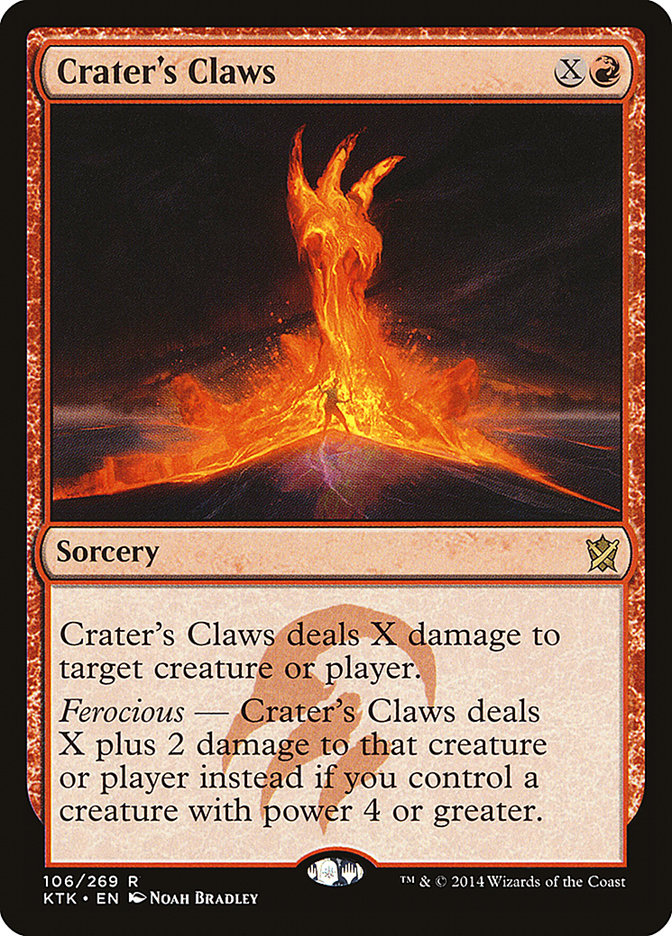We can do it guys!
We can literally do anything!
Offense and defense, at the same time…
Aggressive maneuvers and ones for escaping…
We have the power we need…
And we can have more…
It’s time for…

Knucks…

…
Savage Knuckleblade is technically a real Magic: the Gathering card from the upcoming Khans of Tarkir standalone expansion set. However, in stark contrast
to how real it technically is, it is a very unrealistic Magic card. Understanding just how absurd this particular card is and how to exploit it will be an
important element of the Standard format to come.
Khans of Tarkir is about the five “wedge” color combinations, so named because if you draw a line around the three colored dots on the back of a Magic card
that form a wedge, you would have just drawn a “wedge.” Understanding Wizards of the Coast’s design philosophy can help us make predictions for what the
future of Magic is going to look like, and it should be easy to guess that they are going to try to make all five enemy wedge color combinations good for
Constructed tournament play.
Some of those color combinations are already good, just based on Theros Block. Abzan (BGW) and Sultai (BUG) were two of the three best color combinations
in Block and just giving them good mana would ensure they continue to succeed. While they weren’t dominant strategies in Block, Jeskai (UWR), Mardu (BWR),
and Temur (RUG) are going to receive support in the form of gold cards that ensure they crack the top tiers. Most likely, at least three of these color
combinations are tier 1, with the other two being tier 1.5.
Jeskai is a pretty natural control color combination, but it might also be able to be built as aggro control. It’s really just going to depend on what good
blue cards get revealed, because there is a real shortage of good blue cards these days compared to the other colors.
Mardu is one of the least natural color combinations, but when it works, it is generally either a fast aggro deck (when there are enough untapped dual
lands) or a midrange board control deck (when there are enough awesome gold cards).
Finally, Temur is another of the least natural color combinations. The kind of red and green cards that go together are so the opposite of Blue in
strategy, at least in most cases. What is a Temur deck even supposed to look like? Looking at some successful Temur decks of years gone by:
● Zendikar Block Constructed and Standard immediately after – Green for acceleration like Lotus Cobra, Blue for Jace, the Mind Sculptor, and Red for
removal like Forked Bolt.
● Ramp – Green for acceleration, Blue for Mana Leak and Preordain, and Red for burn.
● Birthing Pod in Standard – All three colors contributed important enters the battlefield triggers, but this was another deck enabled by an overpowered
card draw engine.
● RUG Delver – Green for creatures like Tarmogoyf, Blue for library manipulation and counterspells, and Red for burn.
● Various combo decks – Green for acceleration, Blue for Library Manipulation and Counterspells, Red for removal.
It looks like there’s been a fairly consistent way these decks have fit together, even if what that ends up looking like can be quite varied. Green
definitely has mana acceleration to offer, and Red has some burn. Blue, however, is somewhat slacking on its purpose. There are no awesome one-mana library
manipulation spells to smooth draws. There are no counterspells in the same league as Mana Leak. There are no busted blue card draw engines like Jace, the
Mind Sculptor. What is Blue going to bring to the table? Maybe Blue is just the support color, adding to gold cards?
Let’s take a look at Savage Knuckleblade itself.
Any one of these abilities and Savage Knuckleblade would be tournament viable. All three…?
One of the best cards in the set.
To start with, a 4/4 for URG is not very far off. Loxodon Smiter was a staple during its entire lifespan, and while this is slightly harder to cast, it’s
not even clear if this is harder to cast in a three-color deck than something like Brimaz, King of Oreskos.
Another good comparison is Woolly Thoctar:
One of the woolliest thoctars I’ve ever seen, with three less abilities and one more point of power, this was a cross-format staple. How do Savage
Knuckleblade’s abilties stack up versus one point of power?
Evaluating these abilities is a little tricky because there aren’t actually all that many high level tournament cards that have this many useful activated
abilities. An important lesson to remember, however, is that of the Guildmages. Selesyna Guildmage was a tournament powerhouse, even though it didn’t look
immediately amazing to people, because the opportunity cost was so low. When you had extra mana, you could efficiently convert it into value. All you were
really paying for was the 2/2 for two.
Savage Knuckleblade is a 4/4 for three. How is this realistic? You are paying for basically one of these abilities, and that’s assuming you feel somehow
entitled to the Woolly Thoctar curve. What the knuck man?
Three mana to get +2/+2? That makes Savage Knuckleblade an effective 6/6 for the purposes of trying to block it. As the game goes on, it eventually just is
a 6/6 for all practical purposes. That’s some pretty Knight of the Reliquary type stuff man–and honestly, Savage Knuckleblade is more on the Knight of the
Reliquary curve than the Woolly Thoctar curve.
There’s going to be some interesting guessing games going on between Savage Knuckleblade and Sarkhan, the Dragonspeaker. There are going to be times where
you have the Knuckleblade and three extra mana against a red opponent without Sarkhan. If you spend the three mana, you get two extra damage a turn. If you
save the three mana, you can protect the Knuckleblade from the possibility of Sarkhan dealing four to it.
I am really not sure what would be better, a 5/4 for three, or a 4/4 with this Rootwalla ability. It really depends on the format and how much you end up
with mana to spare, how much each magic number means. They are certainly at least in the same league though.
Three mana to return it to your hand? Going long, this is such an incredible option against black removal. Yes, it’s expensive, but they spent three mana
and a card to try to Hero’s Downfall your guy. Spending three mana and no cards to counter it is pretty fantastic.
As if it needed it, this is going to make Thoughtseize even more important of a card. If you are playing a slower strategy, you need a way to stop the
Knuckleblade for realz. You can’t just use a removal spell every turn most of the time. Thoughtseize still means you two-for-one’ed yourself, but at least
you can make the pain stop for a minute.
This blinking ability gives Savage Knuckleblade a resilience to sweepers that is extremely uncommon for midrange fatties. He’s already built for
resilience, living through Lightning Strike, Bile Blight, Anger of the Gods, and Sultai Charm. Even the stuff that would kill him, like End Hostilities,
can be played around if you are willing to commit the mana. All of these little subgames involving Savage Knuckleblade make me really excited for just how
much play there will be to games involving it. When to play the Knuckleblade and whether to use its abilities, or to save your mana to threaten to use
them.
Blinking has lots of fringe applications if you’ve got the mana to fuel the operation. For instance, if you’re just rolling in the mana, you can attack,
then blink the Knuckleblade to build some vigilance. Given enough mana, you can also buy more “enters the battlefield” triggers. For instance, let’s say
you’ve got Temur Ascendancy on the battlefield:
Just think! You can save a mana when you want the Knuckleblade haste!
Okay, more seriously, if you’ve got Temur Ascendancy, Savage Knuckleblade entering the battlefield draws you a card. Have extra mana lying around? Spend
six mana and you can blink the Knuckleblade, recast it, and draw another card. It works perfect with the vigilance plan, but you can also wait until your
opponent’s end step to blink it (waiting to protect it from End Hostilities). Then, on your turn recast the Knuckleblade, give it haste, and don’t miss a
beat. Even if you only have three or four mana lying around, you can still draw some extra cards over time.
Finally, one mana to gain haste? Haste is one of the greatest abilities, but it’s particularly well placed on the Knuckleblade. First of all, obviously,
its blinking ability means it’s going to enter the battlefield an above average number of times. Each time you give it haste, that’s a big chunk of
someone’s life.
A difficult to cast three-drop gaining haste for one extra mana is often going to be very mana efficient. Elvish Mystic + Yavimaya Coast or Mana Confluence
can lead to a turn 2 Knuckleblade, of course, but we’re not always going to be able to open that way. For those non-Mystic draws, we’re probably going to
want Rattleclaw Mystic or Sylvan Caryatid on 2. That ramps us straight into four on turn 3. Savage Knuckleblade lets us be mana efficient, attacking
immediately, so it’s like you cast it on turn 2.
How good is Rattleclaw Mystic?
Well, it’s strictly better than Golden Hind in at least two ways, and Golden Hind was playable, so there’s a real floor there. Generally speaking,
producing three colors is better than Voyaging Satyr’s ability, although admittedly, it doesn’t untap a Nykthos, Shrine to Nyx.
What about the morph ability? Well, that’s kind of two different abilities. First of all, you can play it as a morph at all. That’s not just an opportunity
to buy a second point of power, but it’s a way to hide your other morphs. If you have any awesome morphs in your deck, Rattleclaw Mystic can help disguise
them. For instance, what if you played four Rattleclaw Mystics, one Kheru Spellsnatcher, and one Sagu Mauler?
Going long, opponents won’t know if you have morphed Rattleclaws or deadly tricks. You’ve got five mana and your opponent is considering killing your morph
before it can turn out to be a Spellsnatcher that ruins him by snatching his Hero’s Downfall next turn. Of course, if he pulls the trigger now and it turns
out to be a Sagu Mauler…
In addition to morph hiding your true forces, it also gives you options for those occasional games where you don’t have green mana. Yeah, most opening
hands without green mana aren’t keepable, but if you have a burn spell, a Temple of Epiphany, a Mountain, and a Rattleclaw Mystic, you might want to keep
it (particularly if it’s a six-card hand).
Not only can you morph it for colorless, you can unmorph it for colorless, jump starting your mana development. Not only do you get a green mana as part of
unmorphing it, you can tap the Rattleclaw that turn for a second green mana. Not a lot of morphs cost mana without any colors needed. Kind of interesting
to see what the implications will be…
The morph ability netting you a mana combined with the Rattleclaw’s tap ability means you can ramp straight into six, which is super hot with Soul of
Shandalar, but even slightly off curve, it’s going to be invaluable at times to go into Sarkhan, the Dragonspeaker or Hornet Queen. Like Generator Servant?
Rattleclaw Mystic does a little bit of a Generator Servant impression at times while also being a reliable mana source and not needing to be sacrificed.
Morph letting you ramp straight into six is pretty hot, though it does raise the question of what are you supposed to do when you have it on turn 2 with a
six-drop and no fours. Do you get greedy, wait, and hope you get there? Or do you just play it out so that if you draw a four-drop, you can cast it?
Magma Spray is going to gain a lot of utility given that there are likely going to be quite a number of morphs running around. This, in turn, is going to
make three-toughness creatures better. Of course, there’s still Lightning Strike, Anger of the Gods, and Bile Blight putting pressure on three-toughness
creatures, which boosts four-toughness creatures like the Knuckleblade.
Important sidenote, morphs don’t have names, so Bile Blight doesn’t kill any beyond the first! Actually, this isn’t 100% true. If your opponent Bile
Blights your morph, fearing it will turn out to be a Sagu Mauler, next turn, you can unmorph it, revealing it to be a Rattleclaw Mystic, which then leads
to the demise of his three Rattleclaw Mystics.
You know, since apparently this joker is running one of those Rattleclaw Mystic + Bile Blight decks…
So, how good is Rattleclaw Mystic? Eh, it’s pretty good. I mean, it’s not that different than a Golden Hind, though clearly better. It’s not quite
as good as Sylvan Caryatid, though in an actual Temur deck, I could easily imagine it proving slightly better. The ability to beat down is actually much
appreciated, and I’m not even sure how much blocking Sylvan Caryatid is going to be able to do well. The format is looking really midrangey, but who knows?
Rattleclaw Mystic also becomes much better if you actually want any other morphs.
So, back to the Knuckfather. Give that bro haste and you can hit for four out of nowhere, which is particularly interesting as part of a pattern.
That’s an unusual amount of four damage surprise haste threats. That kind of makes five loyalty a magic number for planeswalkers, which bodes very well for
Sarkhan, the Dragonspeaker while being a little bit of a strike against Nissa, Worldwaker. Interestingly, while this list is all high tier 1 powerhouses,
Sarkhan actually trumps every other card on this list.
Let’s take a minute to look at Sarkhan, the Dragonspeaker. First of all, it’s a five-cost planeswalker that hits as hard as Stormbreath Dragon while also
having the added utility of being able to Flametongue Kavu creatures. Also, unlike Stormbreath Dragon, which loses to Elspeth, Sarkhan, the Dragonspeaker
is well suited to killing Elspeth while dodging her -3 ability.
It’s like Sarkhan is engineered to be the perfect card for the format. It even exactly kills Courser of Kruphix, the default best card in the format
(since, you know, it was the best card in the Block format and fetchlands have taken its power level into the stratosphere).
Sarkhan’s ultimate is the least important of his abilities, but it is still a potent part of the package. He threatens to go ultimate after just two
plusses, and while the ultimate isn’t unbeatable, it’s pretty damn good. You are just going to overpower a lot of people with all those cards. It’s a good
way to not just run out of gas in case an opponent draws a Hero’s Downfall or something.
Sarkhan’s rate is extremely good, like in the same league as Elspeth, Sun’s Champion. Its -3 ability makes it sort of like a Flame Slash cantrip that draws
you a Sarkhan in play rather than a random card. Now, look at the card as a split card that can also be most of a Stormbreath Dragon and you’re getting a
pretty amazing deal for five mana, and that doesn’t even factor in how quickly the ultimate pressures opponents to be proactive.
Sarkhan, the Dragonspeaker is easily one of the top five cards in the set (in contention for number one) and one of the defining cards of the format. Of
course, this is not to say that the card has no drawbacks. First of all, unlike Stormbreath Dragon, it can’t block. Its -3 ability may be excellent at
killing single targets, but he doesn’t matchup that well against fast aggressive swarms.
There’s a lot of competition at the five spot, but I generally think Sarkhan is usually going to beat out the other fives. That said, drawing two Sarkhans
isn’t actually that sweet, so maybe there’s some mixing to be done.
Another weakness of Sarkhan is that he’s vulnerable to more removal than some other planeswalkers. In order to use Sarkhan for anything more than a Flame
Slash, you have to turn him into a creature. Even though he’s indestructible in dragon form, he can still be hit by Silence the Believers, Utter End, and
even a double dose of Bile Blight.
Okay, so Sarkhan, the Dragonspeaker and Savage Knuckleblade are two of the top five cards in Khans of Tarkir? Courser of Kruphix is the default best card
in the format? Let’s put those three in a deck and get down to business!
Creatures (29)
- 4 Elvish Mystic
- 4 Polukranos, World Eater
- 3 Sylvan Caryatid
- 2 Stormbreath Dragon
- 4 Courser of Kruphix
- 1 Keranos, God of Storms
- 3 Soul of Shandalar
- 4 Rattleclaw Mystic
- 4 Savage Knuckleblade
Planeswalkers (4)
Lands (23)
Spells (4)

How many five-drops we should play is an important question to resolve. I mean, Stormbreath Dragon is great, but maybe we want even more Soul of Shandalar
action. Rattleclaw Mystic ramping to six is a small point, but more importantly, Temur Ascendancy is better with the Soul, not to mention if you draw two
five-drops, you are kind of wasting mana compared to drawing a five and a six.
Nissa is probably not what we’re looking for here despite how great of a card it is. The 4/4s don’t actually trigger Temur Ascendancy, and since we’re
mostly in it for the 4/4s, it’s kind of a six-drop, making it have to compete with Soul of Shandalar. Besides, I kind of feel like people’s Nissas are just
going to get Sarkhan’ed an uncomfortable amount of the time.
Keranos, God of Storms could actually prove to be a pretty sweet five. The card’s power level is very high, and it dodges a lot of the stuff that beats
Sarkhan. On the surface, it doesn’t look like it combos with Temur Ascendancy, but the Ascendancy does provide 40% of the extra devotion you need, and if
you actually get there, you do draw an extra card and swing for a ton the turn you play Keranos…
We actually don’t need as many four-drops as we used to, since Savage Knuckleblade is a very effective four-drop. That said, if we want more, there are
lots of good options. Polis Crusher was a block standout, and I would have started with some if not for its vulnerability to Sarkhan. Xenagos, the Reveler
is probably the most likely addition, both for raw power and because of how many ways we have to take advantage of the mana (Knuckleblade, Soul of
Shandalar, Stormbreath’s monstrosity, and Crater’s Claws).
Speaking of Crater’s Claws, it hasn’t gotten much love, but I think it’s likely to turn out pretty decent. Deal X for X mana would be good (in contrast to
X+1 for X damage, like most red X-spells), and if you have a four-power creature half the time, you are sort of getting X for X on the average. Yes, when
you want to kill a small creature on turns 1 or 2, you’re a bit worse off, but when you are actually trying to burn people out, you are generally better
off. This might not revolutionize the format, but it seems like it should be good to me. I particularly like that it can kill opposing Sarkhans for four
mana. Worth noting, if you have Sarkhan yourself, he turns on your Crater’s Claws for some serious damage.
Crater’s Claws just kind of makes sense in the format. A lot of creatures you’d want to kill on turn 2 have just one point of toughness, but going long, it
puts your extra Courser of Kruphix mana to excellent use.
Verdict: Format role-player.
Why the hell would I want Temple of Epiphany instead of more Frontier Bivouacs? Well, you only need so much green mana, and with eleven mana creatures plus
tons of green lands, we’re kind of doing alright in that department. Temples are more powerful than tri-lands, so if you can get away with them, you really
want to.
Why not use more Temples, in that case? Well, I wanted to maximize the amount of untapped green sources for when you draw Elvish Mystic. However, even if
you draw Elvish Mystic, having your blue-red dual come into play tapped is often okay. Yeah, it can disrupt some number of turn 2 Knuckleblades, however,
all these painlands can really add up. This list has eight ways to go from Elvish Mystic into Knuckleblade, but we might just want to slow things down a
little, get more power and less pain, even if it costs us a little speed.
I’m also splitting the Temples and tri-Lands at the moment, to hedge against people killing our mana creatures. After all, we do want to make sure we can
still cast our Courser of Kruphix, so we have to be mindful of how much non-green mana we play. I sure do hope we can get away with more Temples though.
They are really, really good…
This manabase isn’t optimized for double blue, but with both Sylvan Caryatid and Rattleclaw Mystic, maybe we could get away with sideboarding some double blue cards. Besides, if we wanted to, we could trim a Forest for a Temple of Mystery or another Frontier Bivouac. Fetchlands are awesome, but cutting a Wooded Foothills is totally on the table. Even though it helps cast Elvish Mystic turn 1, it doesn’t actually help the turn 2 Knuckleblade, unless you had a Yavimaya Coast or a Mana Confluence so that you can save it to get a Mountain.
My biggest concern with this current build is that we’re lacking much interaction, particularly against other fatties. Even just facing an opposing
Polukranos or any of the Souls could be potentially problematic. Maybe sideboarding Polymorphist’s Jest is an option to help alleviate this weakness?
One big X-factor is what Temur Charm does. If Temur Charm’s Blue ability is bounce target non-land permanent, it could add a valuable dimension to this
deck (assuming the other two modes bring enough to the table). I doubt the mode I’m about to suggest is on the card, but it’d be sweet if one of the modes
was to put a 4/4 haste creature into play that is sacrificed at the end of the turn. It’s sort of a removal spell (since it’s an instant) and sort of a
burn spell (since you can nug people), plus it powers up your four or more power theme.
Another possibility I could imagine is a strange sort of Firespout variant, where it deals three to all fliers or deals three to all non-fliers, or bounces
a non-land permanent. I’m not sure I like the idea of an instant speed three-cost sweeper at that power level that is easy to maindeck four-of, but who
knows? Maybe it deals two damage and is at least halfway realistic.
I kind of hope it’s not a sweeper variant though, as Temur decks seem so mana-creature-centric. Whatever it ends up being though, if it ends up as a good
trick for helping temporarily deal with a giant threat, it might be exactly what the doctor ordered. Even just some counterspell variant might be awesome,
you know, like if one of the modes is some kind of Mana Leak. That actually sounds super hot!
Just imagine, Mana Leak, Lightning Strike, or Fog. That would be so sick for giving us options for racing! I seriously doubt Fog would be a mode, however.
It seems more likely to be a trampling Giant Growth variant or just making a token (4/1 trample would be sick, if not super green).
Anyway, Temur may not naturally have much reason to exist from mono-colored cards alone, but Savage Knuckleblade is so absurd, the deck will exist and will
probably be tier 1. There are so many great tools for R/G anyway, so it’s really just a question of the Temur gold cards versus stuff like Elspeth.
Rotations always bring upheaval to formats, but this is a totally new world, we’re talking about here.
Let the brewing begin!

